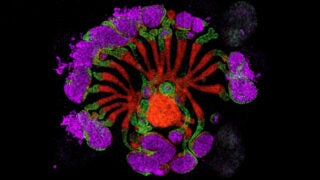USC Eye Institute study seeks cures to childhood myopia
Study of 9,000 Los Angeles-area children confirms global trend — the incidence of childhood myopia is increasing at an alarming pace
The largest study of childhood eye diseases ever undertaken in the United States confirms that the incidence of childhood myopia among Americans has more than doubled over the last 50 years.
The findings echo a troubling trend among adults and children in Asia, where 90 percent or more of the population has been diagnosed with myopia, up from 10 to 20 percent 60 years ago.
The Multi-Ethnic Pediatric Eye Disease Study (MEPEDS), conducted by researchers and clinicians from the USC Eye Institute at Keck Medicine of USC in collaboration with the National Institutes of Health, adds to a growing body of research into the incidence and potential causes of myopia, or near-sightedness, in children and adults.
The possible culprit? Too much “screen time” and not enough sunlight, according to Rohit Varma, director of the institute.
“While research shows there is a genetic component, the rapid proliferation of myopia in the matter of a few decades among Asians suggests that closeup work and use of mobile devices and screens on a daily basis, combined with a lack of proper lighting or sunlight, may be the real culprit behind these dramatic increases,” Varma said. “More research is needed to uncover how these environmental or behavioral factors may affect the development or progression of eye disease.”
Clear or blurry?
Myopia is a condition where objects up close appear clearly, while objects far away may appear blurry. With myopia, light focuses in front of the retina (the light-sensitive tissue at the back of the eye) rather than on the retina. There currently is no cure, although its progression can be slowed.
The USC study found that the incidence of childhood myopia in the U.S. is greatest in African-American children, followed by Asian-American children, Hispanic/Latino and non-Hispanic white children. Future research may include re-examining the MEPEDS cohort to evaluate how widespread use of “screens” and other environmental or behavioral factors may be affecting the progression of childhood myopia and other eye diseases over time.
First study of its kind
From 2003 through 2011, MEPEDS provided free eye exams at USC Eye Institute clinics to more than 9,000 Los Angeles-area children ages 6 months through 6 years.
By including younger children, we have the opportunity to identify eye diseases and their causes at the formative stages.
Rohit Varma
“In addition to being the largest pediatric eye study ever undertaken, it is the first of its kind to examine children as young as 6 months old,” Varma said. “Typically, children do not undergo vision testing until they reach school age. By including younger children, we have the opportunity to identify eye diseases and their causes at the formative stages.”
USC Eye Institute researchers and clinicians collected basic health information during a home visit with the child and parents, followed by a detailed eye examination under dilation that collected more than 5,000 eye measurements for each child. To date, data from the USC study has generated more than 20 academic papers on the prevalence of childhood eye diseases, including myopia, hyperopia (far-sightedness), amblyopia (so-called “lazy eye”) and strabismus (abnormal alignment of the eyes).



